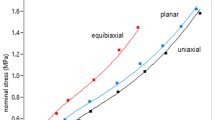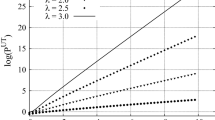Abstract
In this paper a simplified three-dimensional constitutive equation for viscoelastic rubber-like solids is derived by employing a generalized strain measure and an asymptotic expansion similar to that used by Coleman and Noll (1961) in their derivation of finite linear viscoelasticity (FLV) theory. The first term of the expansion represents exactly the time and strain separability relaxation behavior exhibited by certain soft polymers in the rubbery state and in the transition zone between the glassy and rubbery states. The relaxation spectra of such polymers are said to be deformation independent. Retention of higher order terms of the asymptotic expansion is recommended for treating deformation dependent spectra.
Certain assumptions for the solid theory are relaxed in order to obtain a constitutive equation for uncross-linked liquid materials which exhibit large elastic recovery properties.
Apart from the ‘strain energy’W(I1,I 2), which alternatively characterizes the long-time elastic response of solids or the instantaneous elastic response of elastic liquids, only the linear viscoelastic relaxation modulus is required for the first-order theory. Both types of material functions can be obtained, in theory, from simple laboratory testing procedures. The constitutive equations for solids proposed by Chang, Bloch and Tschoegl (1976) and a special form of K-BKZ theory for elastic liquids are shown to be particular cases of the first-order theory.
Previously published experimental data on a cross-linked styrene-butadiene rubber (SBR) and an uncross-linked polyisobutylene (PIB) rubber is used to corroborate the theory.
Similar content being viewed by others
References
Smith TL, Dickie RA (1969) J Polym Sci, A-2, 7: 635–658
Tobolsky AV, Andrews RD (1945) J Chem Physics 13: 3–27
Guth E, Wack PE, Anthony RL (1946) J Applied Phys 17: 347–351
Chang WV, Bloch R, Tschoegl NW (1977) J Polym Sci 15: 923–944
Smith TL, Frederick JE (1968) Trans Soc Rheol 12: 363–396
Halpin JC (1965) J Appl Phys 36: 2975–2982
Leaderman H (1962) Trans Soc Rheol 6: 361–382
Chang WV, Bloch R, Tschoegl NW (1976) Rheol Acta 15: 367–378
Bloch R, Chang WV, Tschoegl NW (1978) J Rheology 22: 1–32
Seth BR (1964) Generalized strain measure with applications to physical problems, in: Reiner M, Abir D (eds), Second-order effects in elasticity, plasticity and fluid dynamics, Pergamon, Oxford, p 162–172
Seth BR (1964) Generalized strain and transition concepts for elastic—plastic deformation — creep and relaxation, IUTAM Symposium, Munich, Pergamon Press, p 383–389
Coleman BD, Noll W (1961) Rev Mod Phys 33: 239–249
Kaye A (1962) College of Aeronautics, Note 134. Cranfield, Bletchley, England
Bernstein B, Kearsley EA, Zapas LJ (1963) Trans Soc Rheol 7: 391–410
Del Piero G (1979) J Elasticity 9: 245–261
Halmos PR (1958) Finite — dimensional Vector Spaces, New York, Van Nostrand
Dill EH (1971) Simple materials with fading memory, Chapter 4, in: Eringen AC (ed), Continuum Physics, Vol 2, Academic Press, New York, p 283–403
Truesdell C, Noll W (1965) The Non-Linear Field Theories of Mechanics, in: Flügge S (ed), Encyclopedia of Physics, Vol III/3, Springer-Verlag, Berlin
Hill R (1968) J Mech Phys Solids 16: 229–242
Morman KN (1986) J Appl Mech 53: 726–728
Blatz PJ, Sharda SC, Tschoegl NW (1974) Trans Soc Rheol 18: 145–161
Ogden RW (1973) Rubber Chemistry and Technology 46: 398–416
Goldberg W (1967) An Experimental Investigation of Nonlinear Isothermal Viscoelasticity, Doctoral Thesis, Purdue University
McGuirt CW, Lianis G (1969) Experimental investigation of nonlinear viscoelasticity with variable histories, in: Onogi S (ed), Proceedings of the Fifth International Congress on Rheology, Vol 1, p 337–352
McGuirt CW, Lianis G (1970) Trans Soc Rheol 14: 117–134
Hopkins IL, Hamming RW (1957) J Appl Phys 28: 906–909
Krylov VI (1962) Approximate Calculation of Integrals, MacMillan Co, N.Y.
Author information
Authors and Affiliations
Rights and permissions
About this article
Cite this article
Morman, K.N. An adaptation of finite linear viscoelasticity theory for rubber-like viscoelasticity by use of a generalized strain measure. Rheol Acta 27, 3–14 (1988). https://doi.org/10.1007/BF01372444
Received:
Revised:
Issue Date:
DOI: https://doi.org/10.1007/BF01372444




